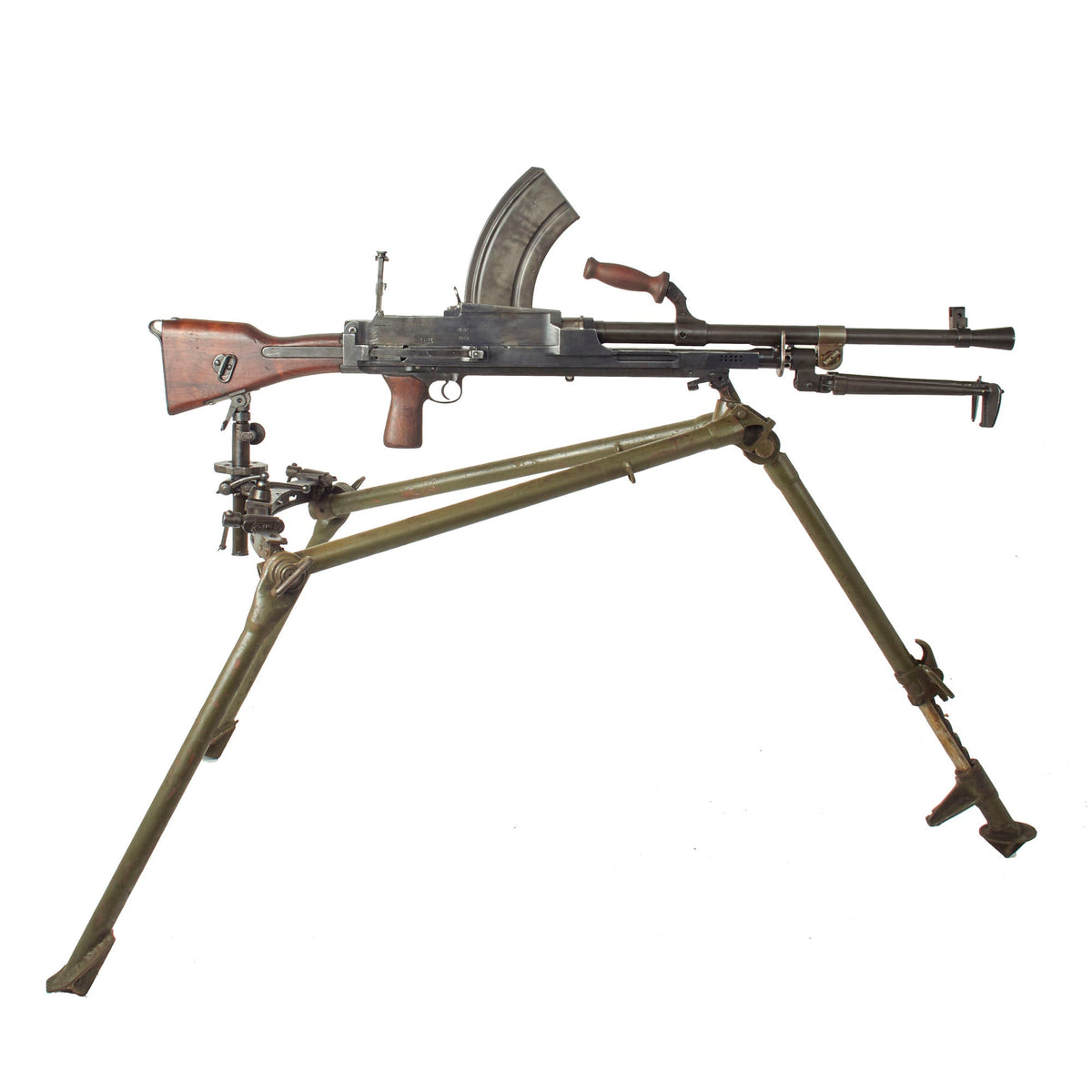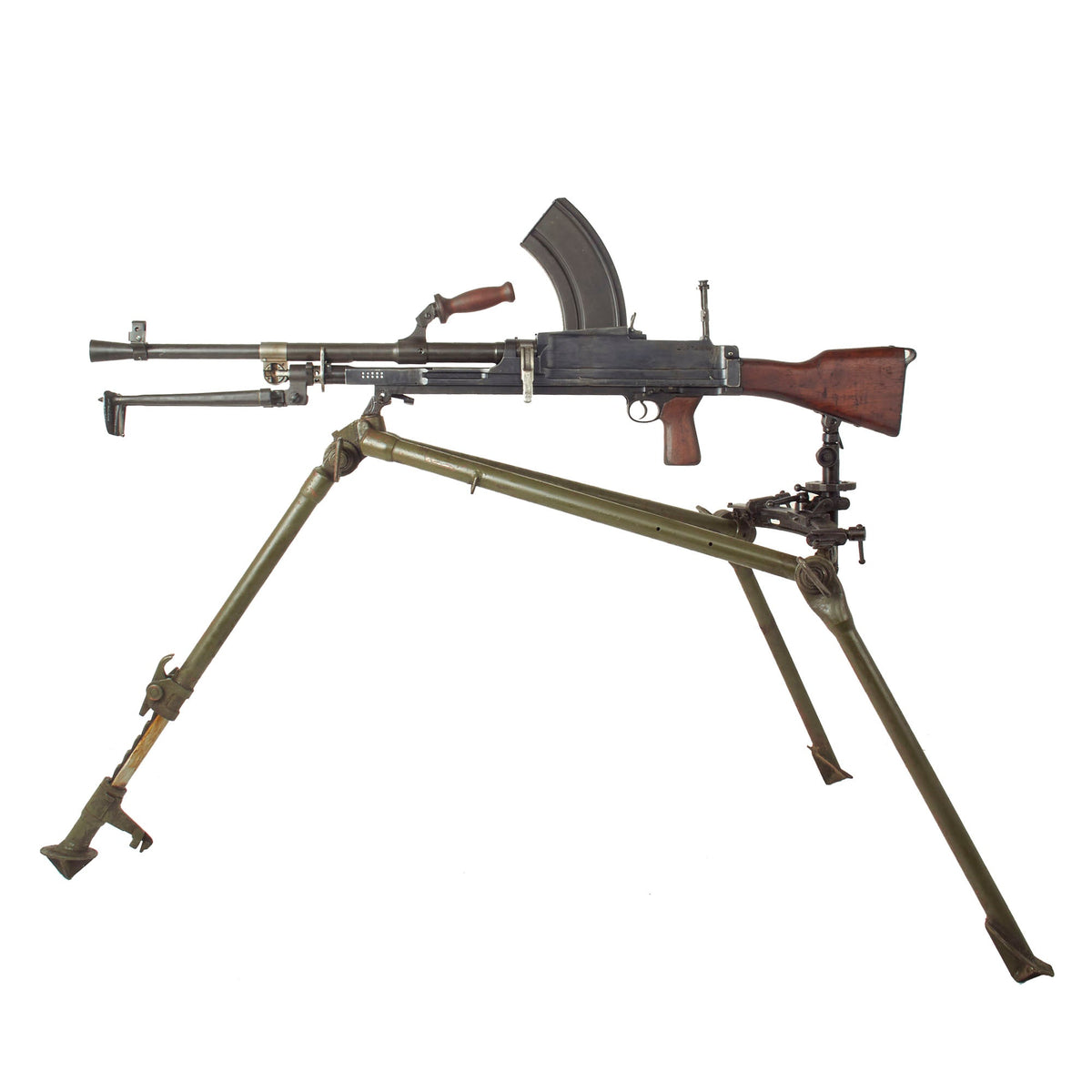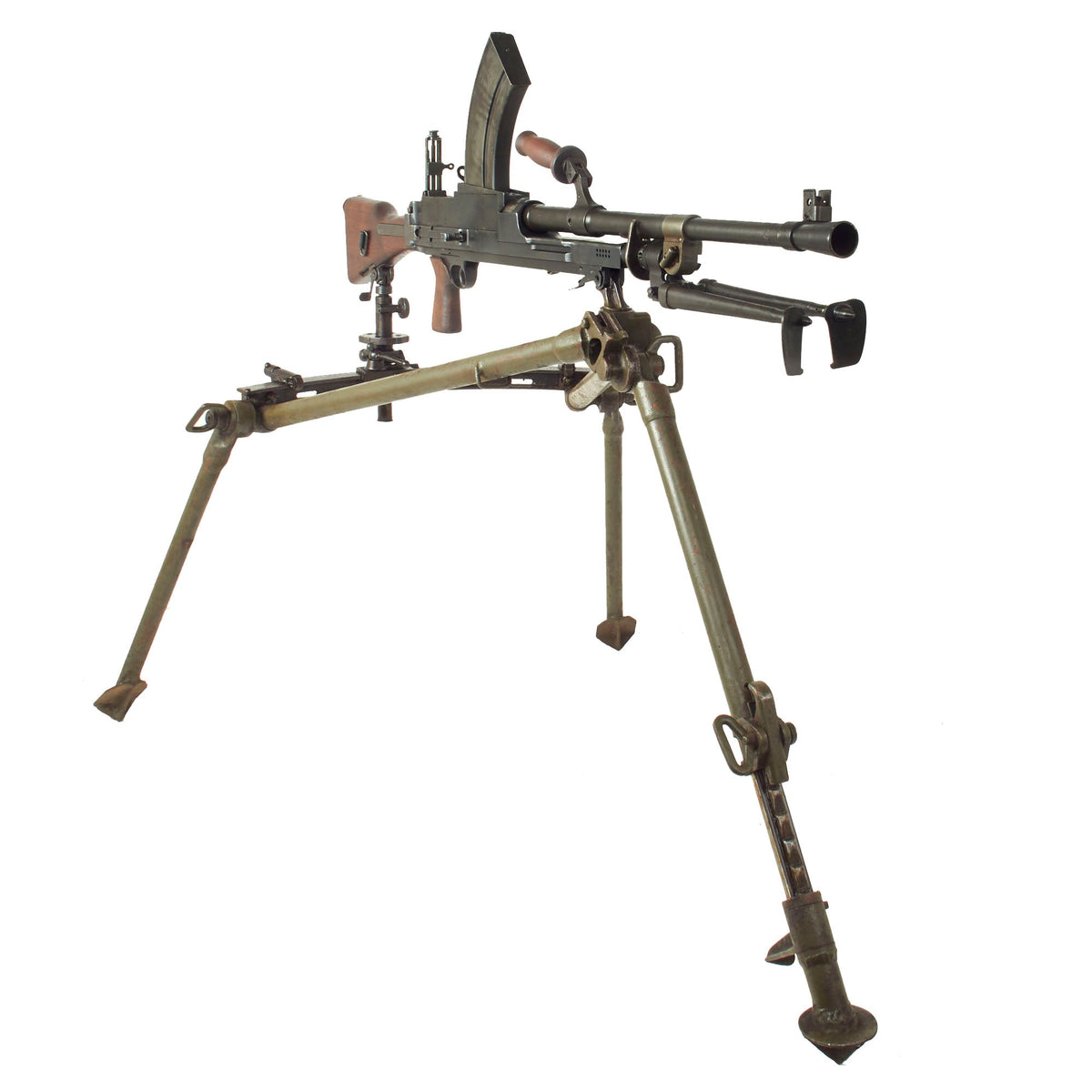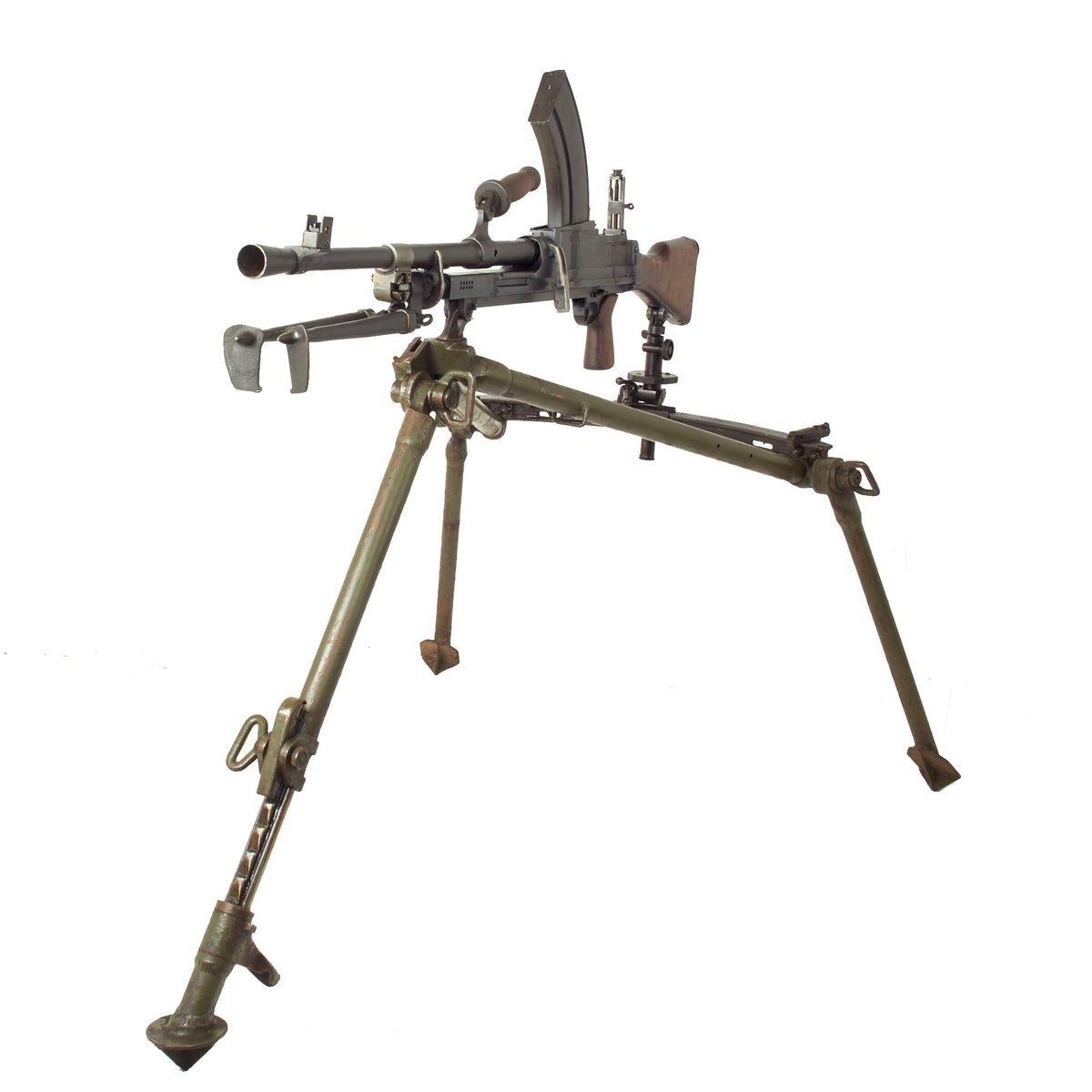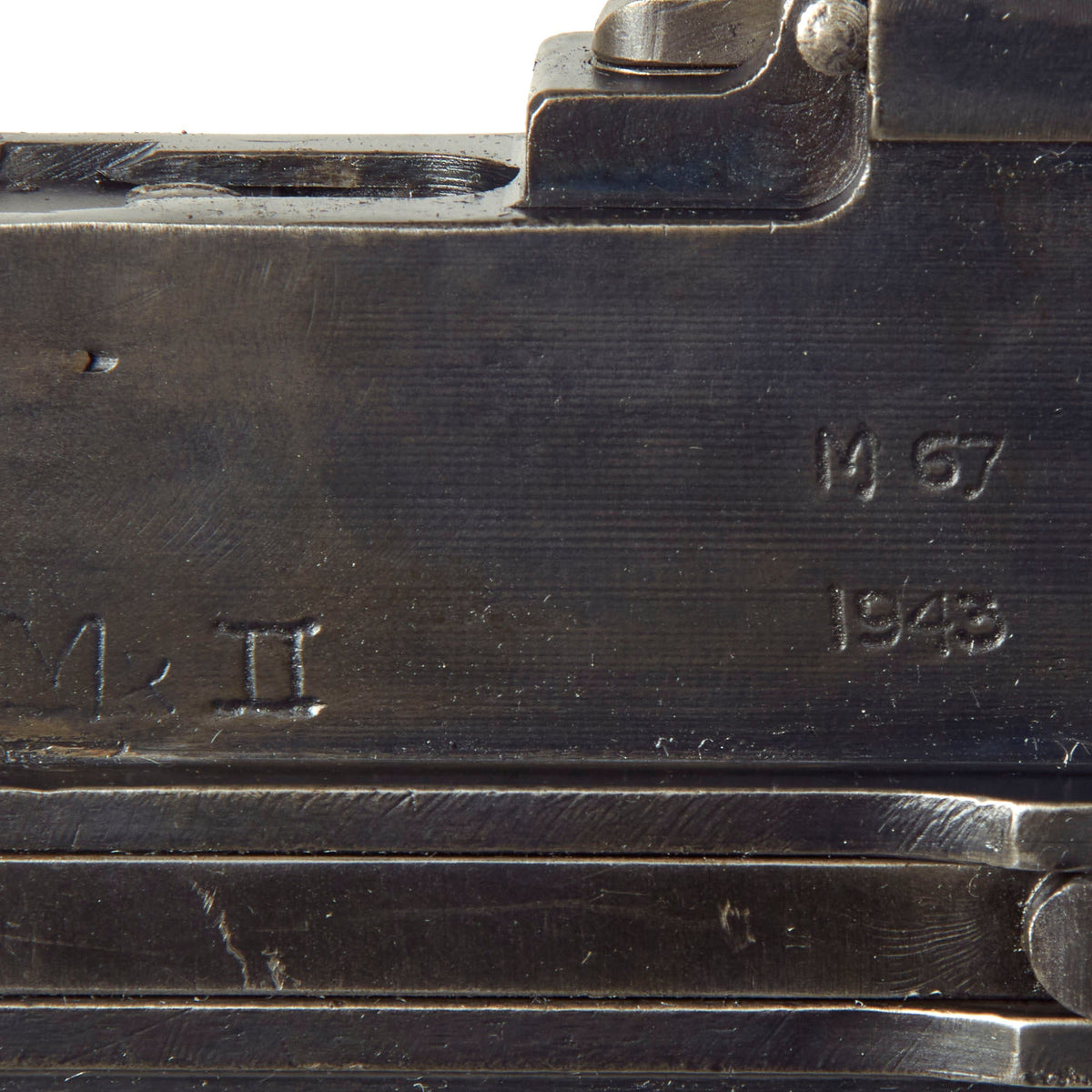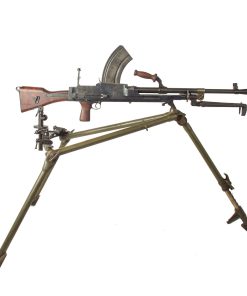Original British WWII 1943 Dated Bren MkII Display Light Machine Gun by Monotype with Early 1940 Dated Tripod & Magazine Original Items
$ 3.095,00 $ 773,75
Original Item: Only One Available. This is a fantastic example of the iconic Bren Light Machine gun, as used by British forces during WWII, complete with an original early issue Bren Tripod mount. The display gun is constructed from Original British WWII Parts with a BATF complaint non-firing cut and blocked display receiver. 2 inches of the receiver has been replaced by solid steel bar stock as required. Additionally, the barrel has been demilitarized by having the chamber welded up and modified during importation.
The display gun is partly marked BREN Mk II on the rear receiver over the cocking lever, with serial number U5947 on the end of the receiver. It is also marked M 67 / 1943 farther up the receiver, which is the dispersal code for the Daimler Company Limited, an automobile manufacturer. It was part of the Monotype Group – a confederation of companies making parts which were assembled by the Monotype Corporation in Surrey. They produced around 72,000 Bren Guns from September 1941 onwards during the war. The loss of large numbers of Bren Guns at Dunkirk had resulted in the War Department contracting with many companies not previously involved in arms production to start production.
This display gun has the correct MkII receiver, with a ladder sight attached to the rear, and the correct “high ears” on the front of the gas tube. The butt stock is the correct simplified version, with a sling swivel on the side, and a bent steel butt plate with a “lip” at the top. It has the correct all steel MkII barrel mounted permanently to the front. The lower frame is the correct shorter MkII type, which ends just after the front tripod mounting location, and is fitted with the correct MkII pattern cocking handle. It comes with an original WW2 Bren magazine, which will be deactivated where required.
Overall the display gun is in very nice condition, with much of the original finish present on the original parts. Pistol grip and butt stock are in solid shape, with a great color and grain. There is no crack through the butt stock, as often seen on these due to the “lip” on the butt plate.
The included tripod is a great early type, dated ’40 where the third leg would attach. Condition is very good, with all components present except for the “third leg”, which would be stored inside the horizontal tubes of the tripod. It is fully functional, with all clamps and adjustments fully functional, and a great green finish.
A very attractive display piece for any collection!
The Bren was a licensed version of the Czechoslovak ZGB 33 light machine gun which, in turn, was a modified version of the ZB vz. 26, which British Army officials had tested during a firearms service competition in the 1930s. The later Bren featured a distinctive top-mounted curved box magazine, conical flash hider, and quick change barrel. The name Bren was derived from Brno, the Czechoslovak city in Moravia, where the Zb vz. 26 was designed (in the Zbrojovka Brno Factory) and Enfield, site of the British Royal Small Arms Factory. The designer was Václav Holek, a gun inventor and design engineer.
The Bren was originally very close to the Czech ZB vz 30 in construction, with carefully machined lightening cuts, dovetails, and other precision design elements. However, with the massive loss of arms during the evacuation at Dunkirk, the British Military needed a lot more Bren guns, and fast. Very quickly, a modified MkI Bren, called either the MkIM or MkI*, was introduced, which removed a lot of the bevels and lightening cuts that were machined into the original receiver. The complicated front adjustable bipod was also replaced by one with fixed legs. The extra sight dovetail on the left side was removed completely as well.
However, at the same time the MkI Modified was being developed, plans were already in motion for an even simpler redesign for new production lines that were not already set up to make the MkIM This new design involved a much simpler squared rear receiver, and did away with the complicated dial-driven rear sight. Instead a standard fold-away ladder sight was developed. The rear butt stock was dramatically simplified in design, being more of a slab, and it had a simple bent steel butt plate that screwed directly onto the wood. The MkI had a utilized a stamped “Cup” that snapped into special slots, and had a fold-away shoulder rest.
The most noticeable change to the layman however would be the new barrel. gone was the long stainless steel barrel shroud and flash hider that extended to the gas regulator. Instead, the flash hider was now pressed onto the end of the barrel, and was only about 3 inches long in total, with the front sight another piece that was pressed on. All of these changes together dramatically sped up production
The production of the Bren began at Enfield in 1937 and for every three guns produced, a tripod was also manufactured. The problem was that the Bren was not capable of fulfilling the role performed by the Vickers. While leaving the tripod as a useful accessory, this meant that the initial importance of it was now secondary. Likewise, the Fixed Line Sight, which was intended to be fitted to the additional open dovetail fixing when the Bren was deployed on the tripod in the sustained fire role, was considered obsolete.
The AA conversion involved a wonderful piece of engineering; the additional leg (which comprised two sections) was stored in the hollow tubes of the main frame when not in use and the fixing point utilized the same fitting and tooling used for the SMLE and the 1907 pattern bayonet. The seminal book, The Bren Gun Saga, does not indicate if this tooling option was merely a decision based on a combination of saving cost and time, or if it was done in order to make possible what resulted in the event of losing one or both sections of the additional leg, A standard-issue SMLE could be used in lieu of this item to create the required conversion. Unfortunately, as with the intended sustained fire option, the AA conversion was a short-lived concept. The speed of aircraft in the late 1920’s compared to that of those encountered just ten years later meant that the rate of fire of the Bren (450 rpm) was too slow to make the use of the AA point a practical option.
The tripods continued in use, despite the drawbacks highlighted above, throughout the war and a simplified version was also produced after Dunkirk, which omitted the AA leg (although curiously retained the ability of the SMLE to still complete the conversion), Many were later converted to allow for use with the American 30 Cal Browning.
Fast Shipping with Professional Packaging
Thanks to our longstanding association with UPS FedEx DHL, and other major international carriers, we are able to provide a range of shipping options. Our warehouse staff is expertly trained and will wrap your products according to our exact and precise specifications. Prior to shipping, your goods will be thoroughly examined and securely secured. We ship to thousands clients each day across multiple countries. This shows how we're dedicated to be the largest retailer on the internet. Warehouses and distribution centres can be located throughout Europe as well as the USA.
Note: Orders with more than one item will be assigned a processing date depending on the item.
Before shipping before shipping, we'll conduct a thorough inspection of the items you have ordered. Today, the majority of orders will be delivered within 48 hours. The delivery time will be between 3-7 days.
Returns
The stock is dynamic and we cannot completely manage it because multiple stakeholders are involved, including our factory and warehouse. So the actual stock may alter at any time. It's possible that you may not receive your order once the order has been made.
Our policy is valid for a period of 30 days. If you don't receive the product within 30 days, we are not able to issue a refund or an exchange.
You can only return an item if it is unused and in the same state as the day you received it. You must have the item in its original packaging.
Related products
Uncategorized
Uncategorized
Uncategorized
Uncategorized
Uncategorized
Uncategorized
Uncategorized
Uncategorized
Australian WWII Owen MK1 Machine Carbine SMG Custom Fabricated Replica with Sling Original Items
Uncategorized
Uncategorized
Uncategorized
Band of Brothers ORIGINAL GERMAN WWII Le. F.H. 18 10.5cm ARTILLERY PIECE Original Items
Uncategorized
Uncategorized
Uncategorized
Uncategorized
Armored Burgonet Helmet & Polearm from Scottish Castle Leith Hall Circa 1700 Original Items
Uncategorized
Uncategorized
Uncategorized
Uncategorized
